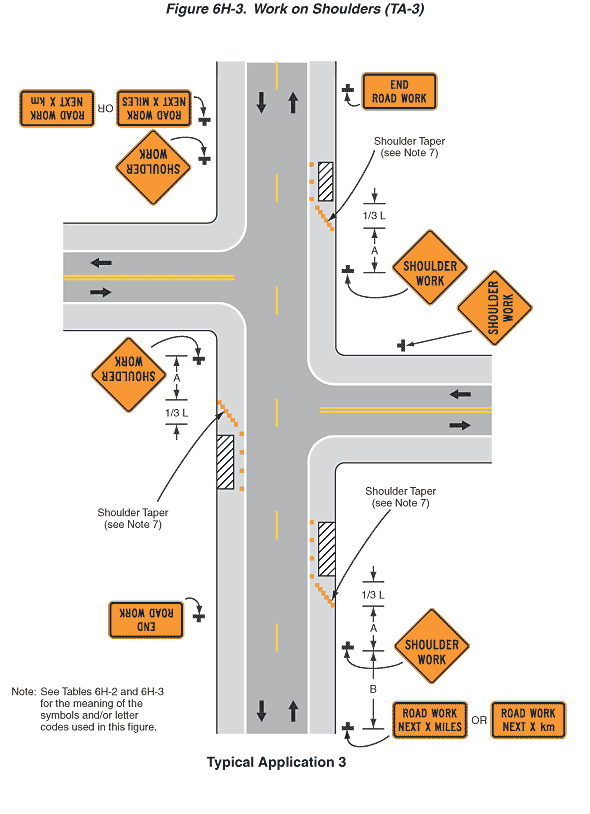
Figure 6H-3. Work on Shoulders (TA-3)
This figure illustrates an example of work on shoulders. A legend under the figure states that this is Typical Application 3. A note states "See Tables 6H-2 and 6H-3 for the meaning of the symbols and/or letter codes used in this figure."
This figure shows a vertical two-lane roadway with one lane of traffic in each direction. A downward-pointing black arrow in the left lane and an upward-pointing arrow in the right lane denote the direction of traffic as southbound and northbound, respectively. The opposing lanes are shown separated by a broken yellow line. A shoulder is shown to the right of each travel lane. The shoulders are shown as separated from the travel lanes by a solid white line.
One-third from the top of the figure, a two-lane horizontal road is shown intersecting the vertical roadway from the left. South of this roadway and in the middle of the figure, a two-lane horizontal roadway is shown intersecting the vertical roadway from the right. On both of these roadways, black arrows indicate that the direction of travel is one lane in each direction, a solid double yellow line is shown separating the opposing traffic lanes, a shoulder is shown to the right of each travel lane, and the shoulders are shown separated from the travel lanes by a solid white line.
At the bottom of the figure and to the right of the shoulder of the right, northbound lane, a black inverted "T" is shown denoting a sign. The sign shown is a horizontal rectangular orange sign with a black border and the words "ROAD WORK NEXT X MILES" in black or the metric alternate "NEXT X km." Beyond the sign, at a dimensioned distance B, a diamond-shaped orange sign with a black border is shown to the right of the shoulder. It has the words "SHOULDER WORK" in black. At a dimensioned distance A, a series of orange squares, denoting channelizing devices, is shown. The devices are shown beginning at the far right edge of the shoulder and tapering to the solid white line separating the shoulder and northbound lane. The length of this shoulder taper is shown as a dimensioned distance 1/3 L, and a note with a leader arrow to the taper refers to Note 7. Within the shoulder, a vertical rectangle is shown with diagonal black and white stripes, denoting a work space, and to the left of the work space, a series of channelizing devices is shown on the shoulder to the right of the northbound lane.
In the middle of the figure, on the north side of the horizontal roadway to the right, a diamond-shaped orange sign with a black border is shown with the words "SHOULDER WORK" in black to the right of the shoulder of the westbound lane. It is shown facing road users approaching the vertical roadway.
On the vertical roadway beyond the horizontal roadway on the right, another diamond-shaped orange sign with a black border and the words "SHOULDER WORK" in black is shown to the right of the right shoulder. At a dimensioned distance A, a series of channelizing devices is shown. The devices are shown beginning at the far right edge of the shoulder and tapering to the solid white line separating the shoulder and northbound lane. The distance of this shoulder taper is shown as a dimensioned distance 1/3 L, and a note with a leader arrow to the taper refers readers to Note 7. Within the shoulder, a vertical rectangle is shown with diagonal black and white stripes, denoting a work space, and to the left of the work space, a series of channelizing devices is shown on the shoulder to the right of the northbound lane. At the top of the figure, a horizontal rectangular orange sign with a black border and the words "END ROAD WORK" in black is shown to the right of the right shoulder.
At the top of the figure and to the right of the shoulder of the right, southbound lane, a black inverted "T" is shown denoting a sign. The sign shown is a horizontal rectangular orange sign with a black border and the words "ROAD WORK NEXT X MILES" in black or the metric alternate "NEXT X km." Beyond the sign, a diamond-shaped orange sign with a black border is shown to the right of the shoulder. It has the words "SHOULDER WORK" in black.
In the middle of the figure, on the south side of the horizontal roadway to the left, a diamond-shaped orange sign with a black border and the words "SHOULDER WORK" in black is shown to the right of the right shoulder. At a dimensioned distance A, a series of channelizing devices is shown. The devices are shown beginning at the far right edge of the shoulder and tapering to the solid white line separating the shoulder and the southbound lane. The distance of this shoulder taper is shown as a dimensioned distance 1/3 L, and a note with a leader arrow to the taper refers to Note 7. Within the shoulder, a vertical rectangle is shown with diagonal black and white stripes, denoting a work space, and to the left of the work space, a series of channelizing devices is shown on the shoulder to the right of the southbound lane. At the bottom of the figure, a horizontal rectangular orange sign with a black border and the words "END ROAD WORK" in black is shown to the right of the right shoulder.
